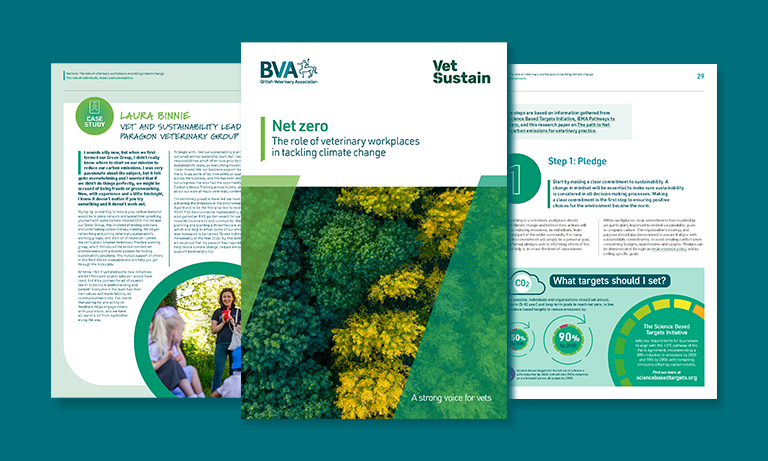Standing up for the veterinary profession
08 Aug 2024
This blog explores the role of veterinary workplaces in environmental sustainability and how our new Net zero report can help inspire change.

What is ‘net zero’?
Net zero means total greenhouse gas emissions are equal to or less than the emissions we remove from the environment, with any residual emissions which cannot be reduced to zero being matched by greenhouse gases being actively removed from the atmosphere. At the UK level, the 'net zero target' refers to a government commitment to ensure the UK reduces its greenhouse gas emissions by 100% from 1990 levels by 2050. If met, this would mean the amount of greenhouse gas emissions produced by the UK would be equal to or less than the emissions removed by the UK from the environment.
Carbon neutral is often used interchangeably with ‘net-zero’, but the two are not the same. In general, carbon neutrality means balancing emissions with carbon offsets, without necessarily having reduced emissions by an amount consistent with reaching net zero at the global or sector level.
Why should vets care?
Climate change will be potentially the biggest global health threat of the 21st century1, and will directly affect the veterinary sector. The science is clear that, in order to avoid catastrophic climate change, rapid reductions in greenhouse gas emissions must be made and ‘net zero’ achieved by the middle of the century2.
Veterinary professionals clearly understand the importance of, and care about environmentally sustainability, and there are strong ethical, business, and one health reasons why the veterinary sector must take action towards achieving net zero. Many have already made significant progress, but there is more work to do.
Considering the role of veterinary workplaces in working towards the UK’s net zero targets is essential, as their work and the animals they care for contribute to global greenhouse gas emissions, and therefore to global warming. The influence of the sector also extends beyond the activities of individual veterinary professionals and businesses, being closely involved with many other sectors, organisations and people who have a direct impact on the environment, including animal owners, the farming community, government, industry, as well as personal and professional communities.
What’s the purpose of our Net zero report?
Our vision is for a veterinary sector in 2050 that has adapted to support the UK’s net zero targets, is trusted on mitigating its own carbon footprint, and leading as a strong advocate for environmental sustainability and its benefits to human and animal health and wellbeing.
So, we developed this report last year (in collaboration with Vet Sustain), drawing on advice from a wide range of trusted sources and research on tackling climate change, to provide guidance for everyone working in veterinary workplaces on how to work towards net zero. It aims to empower and inspire you to engage with sustainability, to help us achieve this vision for the future of our profession and planet.
We recognise everyone will be at different places on their journey and will need their own specific plan, so we’ve included “Four steps to Net Zero” that help to guide anyone aiming to take significant action to reduce their carbon footprint. We’ve included tips for actions at individual, team and profession/community levels, as well as inspiring case studies and links to provide inspiration and information to help everyone contribute towards our vision for a decarbonised veterinary sector.
References
Get tailored news in your inbox and online, plus access to our journals, resources and support services, join the BVA.
Join Us Today